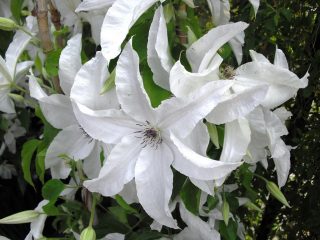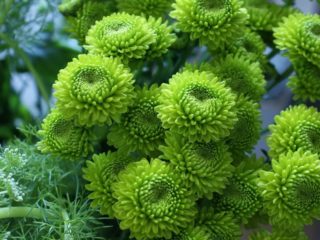Content
Peony Athena is a hybrid recommended for cultivation in most regions of the country. It is a small shrub, about 80 cm high, capable of growing both in the sun and in the shade. The variety has large bicolor buds, which have become its “pass card” in the landscape direction. Has universal application: group plantings, tapeworms, floristry.
Breeding history
Peony Athena was obtained through selection in 1949. The originator of the variety is Saunders.
Description of the Athena peony with photo
At the beginning of the growing season, the Athena peony has no flowers, and the high decorativeness of the plant is achieved due to symmetrical leaves, the edges of which tend to fold towards each other. As a result, the plates take the shape of a boat. They are quite large and have a glossy surface.
Athena peony flowers reach 15 cm and consist of several wide wavy petals. In the center is the most visible part of the plant - the stamens. They cover a significant area of the bud.

The aroma of Athena peony remains elusive
Petals are available in two colors. The background is a creamy shade, and in the middle part, closer to the stamens, you can see a pink striped pattern. This contrast is clearly visible even from afar.
The compact but densely leafy bush is characterized by resistance to aggressive factors - precipitation, mechanical damage, diseases and pests. Despite the large diameter of the inflorescences, the stems of the Athena peony remain straight and do not bend even in the wind.
The variety was created for cultivation in various climatic zones. The plant is frost-resistant, not picky about soil quality. Thanks to this, the Athena peony gained popularity in Russia. It is grown both in the Moscow region and in Siberia.
Timing and flowering period
Athena is an early flowering variety. The plant blooms once a year. The budding period begins in mid-May. At the same time, the duration of the process remains high, the maximum possible is 45 days, that is, approximately until the end of June.
Advantages and disadvantages
The culture is used for cultivation for decorative purposes. Frost resistance and unpretentiousness to external conditions have made the plant popular among gardeners.

A beginner can easily handle planting the Athena peony
Pros:
- the ability to cultivate at home;
- powerful stems do not require supports;
- interesting palette of petals;
- strong immunity.
Minuses:
- weak aroma;
- the need to comply with preventive measures.
When and how to plant
The Athena peony is planned to be planted in spring or autumn. Experts recommend choosing the autumn season so that by next year the bush will be covered with the first inflorescences.A seedling with a root system can be planted directly into the garden.
For this, a seat is prepared. Choose a lighted area with heated and fertilized soil. Although the Athena peony can grow well in the shade, such an environment is not conducive to rapid growth. But planting in partial shade is considered the best option, especially in hot climates.
The planting hole is prepared 3-4 weeks in advance so that the soil is compacted. A drainage element is placed at the bottom of the pit - sand, crushed stone, pebbles. Spread in a layer of 15-20 cm. This measure is necessary to protect the underground part of the peony from rotting. Fertilizer consisting of peat, garden soil and humus is placed on top of the drainage. Athena does not tolerate acidified substrates, so wood ash is added to the fertilizer.
The depth of the hole should be at least 60 cm. The distance from other plants, including seedlings of the same variety, is 50 cm. After completing the pre-planting work, the soil must be given time to absorb the fertilizer.
Then the rhizome is placed in the center of the hole, covered with soil and watered with water (room temperature). Watering should be plentiful. When planting a weakened plant with small buds, the depth of the hole is increased by 5 cm - to protect it from the cold.
When purchasing planting material in the spring, it is better to root it first in a pot and replant it in open ground the next year.The planting procedure is the same, but there is a difference in cultivation - the place should be dark.

Some gardeners use ice instead of water for watering; as the ice melts, the pieces of ice will evenly nourish the roots with liquid.
Care Tips
Peony Athena is unpretentious and easy to grow in open ground and at home. The gardener needs to concentrate on three points: how and how much to water, when to feed and loosen.
Watering is carried out rarely, but abundantly. Once every two weeks, up to 15 liters of water are poured under the root. During the flowering period, the amount of liquid is increased. The same is done during the active growth of the underground part of the peony: at the end of summer and at the beginning of autumn.
To avoid burns, moisturize in the evening or early morning. In this case, water should not get on flowers and greens. Increased moisture levels are a suitable condition for the development of fungal diseases. Therefore, for the purpose of prevention, Athena peony is treated with a fungicidal agent.
Loosening is best done after watering, this will provide direct access of moisture to the roots. The main thing is to be careful - the underground part of the plant is very fragile, especially for young seedlings.
If the soil was well fertilized when planting, there is no need to feed the peony for the next two years. Then the bushes are fertilized twice a season - during the growing season and during flowering. The nutritional mixture can be a complex mineral or organic product. At the same time, it is recommended to focus on nitrogen in the spring, and on potassium and phosphorus in the summer.
Some fertilizers are applied by the foliar method, combining with water and spraying the leaves.To protect against insects, add a little laundry soap to the solution. The soap film also allows the fertilizer to be better distributed over the surface of the plates.
Wintering
Peony Athena is a frost-resistant crop. In the early stages of development, it is covered with mulch; in the second year this procedure is not required.

Peony Athena can withstand cold temperatures down to -38 degrees
Reproduction methods
The hybrid variety cannot be grown using seeds; the planting material has poor germination. Therefore, there are only two methods of propagation - stem cuttings and rhizome division.
Disease and pest control
Although the Athena peony has strong immunity, this does not mean that the owner should neglect preventive treatments. The diseases to which the variety is susceptible include:
- botrytis;
- rust;
- powdery mildew.
They occur due to waterlogging of the soil. Under such conditions, the fungus becomes active. It multiplies quickly and invades the upper (rust, powdery mildew) or underground (botrytis) part of the plant.
During the flowering period, flower growers can witness damage to the Athena peony by ants and aphids. Insects feed on sap. For protection, fragrant crops are planted next to the plant - mint, alyssum, sage. Insecticides are used for direct contact.
How it is used in landscape design

Athena peonies look great near tall green plants

The pointed leaves of the plant can fit into any modern landscape

Athena peonies are often grown in villages; they symbolize the arrival of spring, purity
The plant looks good both in a flowerbed with other flowers and in a solitaire planting.
Conclusion
The Athena peony is a beautiful flower with strong stems and colorful petals.It is used in floristry, landscape design of cottages, gardens and parks.
Reviews from flower growers about the Athena peony








